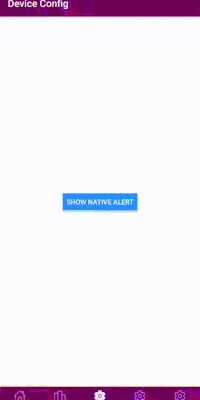Ali
This is a Bridging Challenge React Native project.

Overview
In the real world projects you may face some situation that you will be have to write native codes, this situation may be;
a) the client project has been developed with swift/kotlin and he decides to continue rest of project with react native.
b) there may be a situation that you won’t be able to handle it with react native (utilizin some low-level features such as bluetooth, NFC, payment SDK, etc)
Let’s see how you can handle these situations step by step:
- The React Native (JavaScript) Side
import { NativeModules, TouchableOpacity, Text, Button, View } from 'react-native';
const { DeviceDataModule } = NativeModules; // (1) Get a reference to our native module
const DeviceConfigScreen = () => {
const handlePress = () => {
// (2) Call the exposed native method
if (DeviceDataModule && DeviceDataModule.showToast) {
DeviceDataModule.showToast("1133456"); // (3) Pass data to native
}
};
return (
<View style=>
<TouchableOpacity onPress={handlePress}> // (4) User presses button
<Button title="Show Native Alert" onPress={handlePress} />
</TouchableOpacity>
</View>
);
};
export default DeviceConfigScreen;
What happens here:
a) Const { DeviceDataModule } = NativeModules;
By destructuring AlertModule form NativeModule , you are getting a js object that represents your native Koltin module.
DeviceDataModule.ShowNativeAlert('Hello from Koltin);
This is the magic line!
- The javascript code calls a method (
showNativeAlert) on theDeviceDataModuleobject. - Since the
DeviceDataModuleis a bridging Module , this isn’t a regular js function call. Instead, React Native’s javascript bridge intercepts this call. - The string
"1133456"is passed as an argument across the bridge.
2. The JavaScript Bridge
This is the core communication layer between the JavaScript thread (where your React Native code runs) and the Native UI thread (where Android components and Java/Kotlin code run).
When DeviceDataModule.showToast() is called in JS, the Bridge packages up the method name (“showToast”) and its arguments (“Hello from Kotlin!”) into a message.
This message is then sent from the JavaScript thread to the Native UI thread.
3) Android/Koltin side - receiving the call
package com.fitnessApp
import android.widget.Toast
import com.facebook.react.bridge.ReactApplicationContext
import com.facebook.react.bridge.ReactContextBaseJavaModule
import com.facebook.react.bridge.ReactMethod
class DeviceDataModule(reactContext: ReactApplicationContext) : ReactContextBaseJavaModule(reactContext) {
override fun getName(): String {
return "DeviceDataModule" // This is the name exposed to JS
}
@ReactMethod
fun showToast(message: String) {
Toast.makeText(reactApplicationContext,
"The device Id received in Koltin is: $message", Toast.LENGTH_SHORT).show()
}
}
What happens here:
A. override fun getName(): String { return "DeviceDataModule" }: This function is crucial. When React Native starts up, it asks all registered native modules for their names. This is how the NativeModules JavaScript object knows to create a property named DeviceDataModule that points to this specific Kotlin class.
B. @ReactMethod: This annotation is like a public signpost for the JavaScript Bridge. It tells React Native, “Hey, this showToast method can be called directly from JavaScript!” Without this annotation, the method would be invisible to your React Native code.
C. fun showNativeAlert(message: String): When the message arrives from the JavaScript Bridge, the native side looks for a method with the name showToast and the correct argument types (a String in this case). It then executes this Kotlin function.
D. Toast.makeText(reactApplicationContext, "The device Id received in Koltin is: $message", Toast.LENGTH_LONG).show(): This is standard Android Kotlin code. It takes the message string that was passed from JavaScript and uses the showToast API to display a small, native alert on the Android device’s screen.
4. The Native Module Registration
package com.fitnessApp
import com.facebook.react.ReactPackage
import com.facebook.react.bridge.NativeModule
import com.facebook.react.bridge.ReactApplicationContext
import com.facebook.react.uimanager.ViewManager
class DeviceDataPackage : ReactPackage {
override fun createNativeModules(reactContext: ReactApplicationContext): List<NativeModule> {
return listOf(DeviceDataModule(reactContext))
}
override fun createViewManagers(reactContext: ReactApplicationContext): List<ViewManager<*, *>> {
return emptyList()
}
}
// MainApplication.java (simplified)
public class MainApplication extends Application implements ReactApplication {
@Override
protected List<ReactPackage> getPackages() {
List<ReactPackage> packages = new PackageList(this).getPackages();
add(DeviceDataPackage())
}
// ... other methods
}
What happens here:
E. MyDeviceDataPackage.createNativeModules(): When React Native is initializing its native modules, it calls this method on every ReactPackage you’ve registered. You return a list containing an instance of your DeviceDataModule. This is how DeviceDataModule becomes known to the React Native runtime.
F. MainApplication.getPackages(): This is the very first place where your MyDeviceDataPackage gets plugged into the React Native system on Android. When the MainApplication (which is the entry point of your Android app) starts, it builds a list of all ReactPackages. By adding new MyDeviceDataPackage() to this list, you ensure that MyDeviceDataPackage is discovered, and in turn, your DeviceDataModule is registered.
In Summary: The Journey
JavaScript (App.js): You call DeviceDataModule.showNativeAlert(“…”).
JS Bridge: Intercepts the call, packages it, and sends it to the native side.
Android (MainApplication.java -> MyDeviceDataPackage.kt): The app’s startup registers MyDeviceDataPackage, which contains DeviceDataModule.
Android (DeviceDataModule.kt): The native side receives the message, finds the showNativeAlert method (thanks to @ReactMethod and getName()), and executes it.
Native Android System: The Toast.makeText().show() command displays the alert on the screen.
This entire process happens very quickly, making it seem like a direct call, but it’s the bridge and the module registration that make this cross-language communication possible!